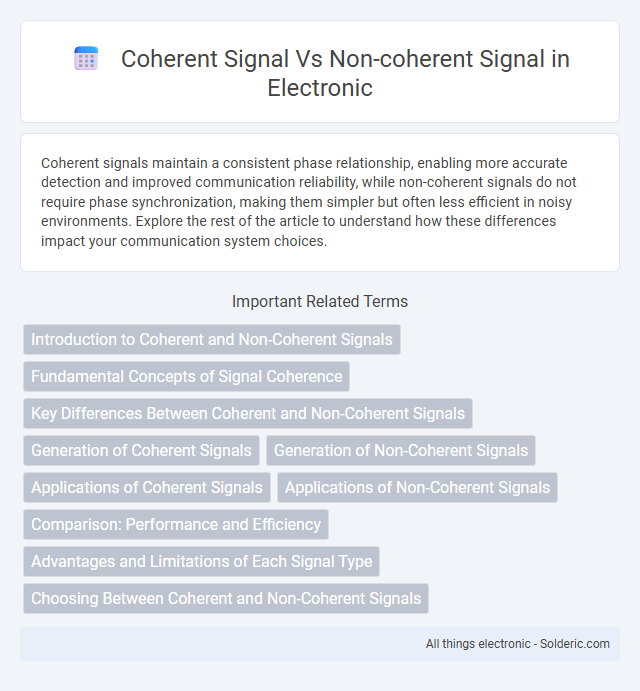Coherent signals maintain a consistent phase relationship, enabling more accurate detection and improved communication reliability, while non-coherent signals do not require phase synchronization, making them simpler but often less efficient in noisy environments. Explore the rest of the article to understand how these differences impact your communication system choices.
Comparison Table
| Feature | Coherent Signal | Non-Coherent Signal |
|---|---|---|
| Definition | Signal with fixed phase reference relative to the receiver | Signal without fixed phase reference; phase varies randomly |
| Phase Information | Preserved for demodulation | Not preserved or used |
| Detection Method | Coherent detection (requires phase synchronization) | Non-coherent detection (does not require phase synchronization) |
| Sensitivity | Higher sensitivity to noise and phase errors | Lower sensitivity to phase errors but generally less sensitive overall |
| Complexity | Complex receiver design (phase tracking needed) | Simpler receiver design |
| Applications | PSK, QAM, coherent radar systems | FSK, ASK, non-coherent radar, simpler communication links |
| Performance | Better bit error rate (BER) under ideal conditions | Higher BER but more robust to phase distortion |
Introduction to Coherent and Non-Coherent Signals
Coherent signals maintain a constant phase relationship with a reference signal, enabling precise detection and demodulation techniques used in applications like radar and communication systems. Non-coherent signals lack phase synchronization, relying on envelope detection or energy detection methods, which simplify receiver design but typically result in lower sensitivity and higher error rates. Understanding the distinction between coherent and non-coherent signals ensures your system design optimizes performance based on phase information availability.
Fundamental Concepts of Signal Coherence
Coherent signals maintain a constant phase relationship and frequency alignment, enabling effective phase-sensitive detection and improved signal-to-noise ratio in communication systems. Non-coherent signals lack fixed phase information, relying primarily on amplitude or frequency variations for detection, which simplifies receivers but reduces sensitivity. Understanding signal coherence is fundamental for optimizing modulation schemes and improving data transmission reliability in radio and optical communications.
Key Differences Between Coherent and Non-Coherent Signals
Coherent signals maintain a constant phase relationship with the reference signal, enabling phase-sensitive detection methods, which improve signal-to-noise ratio and reduce bit error rates in communication systems. Non-coherent signals, however, do not require phase synchronization, relying primarily on signal energy or amplitude, making them simpler to implement but less efficient in noisy environments. Understanding these key differences helps You choose the appropriate modulation and detection techniques for optimal system performance.
Generation of Coherent Signals
Coherent signals are generated using a stable reference oscillator that provides a constant phase and frequency, ensuring signal synchronization in communication systems. Techniques such as phase-locked loops (PLLs) and direct digital synthesis (DDS) are commonly used to produce coherent signals by maintaining a fixed phase relationship between the carrier and the reference signal. This precise phase control enables coherent detection methods, which improve signal-to-noise ratio and overall communication reliability compared to non-coherent signals generated without phase reference.
Generation of Non-Coherent Signals
Non-coherent signals are generated without maintaining a fixed phase relationship between the transmitter and receiver, often using simple modulation schemes such as amplitude shift keying (ASK) or frequency shift keying (FSK) without phase tracking. This generation process involves random or independent carrier phase variations, making the signal detection rely primarily on energy or envelope detection rather than phase information. Non-coherent signal generation simplifies receiver design and reduces synchronization requirements, which enhances robustness in noisy or multipath environments.
Applications of Coherent Signals
Coherent signals are widely used in radar systems, allowing accurate velocity measurements through Doppler frequency shifts and enhancing target detection in cluttered environments. In telecommunications, coherent detection improves spectral efficiency and signal-to-noise ratio, benefiting high-capacity fiber optic and wireless communication links. Your ability to leverage coherent signals in these applications ensures superior performance and reliability compared to non-coherent signal processing methods.
Applications of Non-Coherent Signals
Non-coherent signals are widely used in applications where simplicity and robustness are essential, such as in digital communication systems including frequency-shift keying (FSK) and on-off keying (OOK) modulation schemes. These signals do not require phase synchronization, making them ideal for low-power devices and environments with significant noise or fading, such as wireless sensor networks and remote monitoring systems. Your choice of non-coherent detection can improve system reliability and reduce hardware complexity in scenarios where coherent detection is impractical.
Comparison: Performance and Efficiency
Coherent signals offer higher detection accuracy and better performance in noisy environments due to phase synchronization, making them ideal for complex modulation schemes like PSK and QAM. Non-coherent signals, while less sensitive to phase errors, provide simpler receiver designs and improved robustness in fast-fading channels, leading to increased energy efficiency and reduced computational complexity. Performance trade-offs between coherent and non-coherent detection highlight the balance between accuracy and efficiency, influencing their suitability for applications such as radar, wireless communication, and digital broadcasting.
Advantages and Limitations of Each Signal Type
Coherent signals offer higher accuracy and improved detection capabilities due to their phase synchronization, enabling better performance in low signal-to-noise ratio environments. Non-coherent signals provide simpler receiver design and lower processing complexity, making them suitable for systems where phase information is unreliable or difficult to maintain. Coherent detection faces limitations such as increased hardware complexity and sensitivity to phase noise, while non-coherent detection typically exhibits reduced sensitivity and lower overall signal reception quality.
Choosing Between Coherent and Non-Coherent Signals
Choosing between coherent and non-coherent signals depends on system complexity, performance requirements, and noise environments. Coherent signals provide better sensitivity and lower error rates by maintaining phase information, ideal for applications requiring high accuracy like radar and digital communication. Non-coherent signals simplify receiver design and improve robustness in fading channels, making them suitable for low-cost or low-power wireless systems where phase synchronization is challenging.
Coherent signal vs non-coherent signal Infographic

 solderic.com
solderic.com